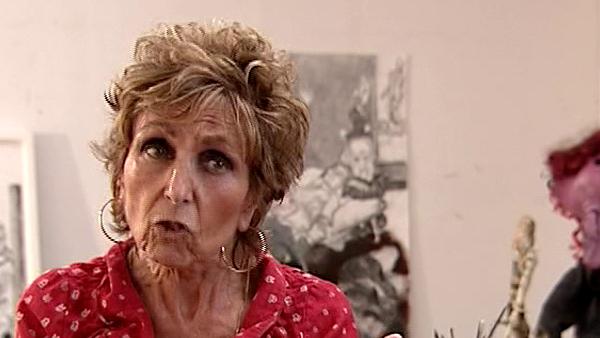I tell you something which is quite interesting. Working in Hampstead in a tiny, tiny room and I... because I’d seen an exhibition by Brennan... Do you know Brennan, that man... is it Brennan who used to sell his pictures for wine? Who... an expressionist, a down-and-out expressionist? Not Gerald Wilde, no? Yeah, Gerald Wilde, Gerald Wilde. And I saw this exhibition of Gerald Wilde and I thought it was wonderful. And Timmy Hilton — the curator of this exhibition — I thought, well, this man should come and look at my work because he might like it, you know. I asked him — Hilton — to come up and look at my work, and Tim Hilton said like this: ‘This... this is awful’, he said. ‘You know, you’re completely wrong’ he said to me, ‘you’re completely wrong. You say you need a story to do your pictures; you don’t need a story at all. You know what you need, you need like this: a long canvas, five colours, different brushes, and you start. You dip a brush and you cover the canvas from left to right and then you dip another brush in another colour and from right to left, and when it’s full it’s a picture’. Terrible. So, oh, God, when he went away I cried and I cried. I cried and I thought I’ll give it a try. So I went to Portugal and I did this. I tried to do this... this thing with... with paint and putting it across and, of course, it didn’t mean anything, didn’t mean a... so I had to give up and go back to doing my things; that was a disaster, silly man. Silly man, imagine saying that?
And so then I went back to doing these collages but very slowly, the way of doing, you see, became academic. That is it say it became a way of doing and when it becomes like that, that’s rubbish then, because you are... you become a system. It becomes a way of doing it and you’re not... you... you forget what it is that... what story you’re telling and you... it’s just a... So I was not happy and I was doing... one day I was... I’d hired this studio, very big studio in Bury Street. It had been Vic’s studio and I was doing some monkeys, just cut them up, and my friend, João Penaloa came along and he said, ’What are you going to cut up those monkeys for, they’re lovely like that’. But this was already in 1979, you see, so things were changing. You didn’t have to do art anymore, which is so disgusting to do art, there’s nothing worse. And he said, ’You can’t... you can just... just leave them, they’re so nice’. ‘Do you think I could?’ I said. ’Yeah’. So, God, that was like freedom again... freedom again. And that was in gouache was it? Yeah, it... yeah it was acrylic... acrylic, watered down acrylic draw... draw. So I drew and drew and drew monkeys and half ant, half beasts and... and just... I didn’t have to cut them up and do art, you see, and it was those monkeys beating his adulterous wife and those pictures that I showed at the Air Gallery. And Robert McPherson, who saw... who was the only one who didn’t cringe when he came to look at my pictures, he actually said, ’Okay, we’ll give you a show at the Air Gallery’. And I was so thrilled, I was quite old already, I was 40. I remember it really well. Do you? Well, I remember Bob, my husband, he was on the committee and Patrick Simons. And they... when Robert McPherson said, ’Oh yes, this is good’. Oh, you see, there you are, that’s wonderful. So I was so pleased, I couldn’t believe it. It was so wonderful. I think... I think that McPherson had also run the Gainsborough House. There was a friend of Susan and Patrick George and so-on. He was very kind and... and then I did those monkeys beating his wife especially for the show.






